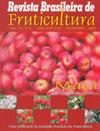Seasonal nutrient content variation in avocado leaves of ‘Geada’, ‘Fortuna’ and ‘Quintal’ genotypes
IF 0.9
4区 农林科学
Q4 HORTICULTURE
引用次数: 0
Abstract
Abstract Avocado is an important fruit for fresh consumption and as raw material for several industries. In order to obtain good productivity and fruit quality, adequate plant nutrition is essential. However, information on the relationship between time of year, phenology and nutritional status of plants of different genotypes is difficult to compare, as most data are obtained from plants of different ages, planted in soils with different fertility levels, different management strategies and most cultivated under edaphoclimatic conditions different from those of Brazil. This study evaluated the seasonal nutrient content variation of avocado leaves, genotypic differences, the relationship with phenological stages and the periods of greater nutrient content stability in ‘Fortuna’, ‘Geada’ and ‘Quintal’ avocado genotypes cultivated in the municipality of Jardinópolis-SP, Brazil. All plants aged 30 years, were randomly planted within the same area and submitted to the same cultural treatments and management. Nutrient contents are more stable during the flowering phase (July to September) and in the final phase of fruit formation (February to March). In most of the cycle, ‘Geada’ plants have lower S, P and Zn levels compared to ‘Fortuna’ and ‘Quintal’ genotypes. ‘Fortuna’ genotype has higher Ca, Mg and Mn levels than the others at the time of fruit harvest (April to June). In the budding phase of the three genotypes (October), increase in N, P, K, S, Cu, Zn contents and decrease in Ca, Mg and Mn contents were observed.‘Geada’、‘Fortuna’和‘Quintal’基因型牛油果叶片养分含量的季节变化
牛油果是一种重要的鲜食水果,也是许多工业的原料。为了获得良好的产量和果实品质,充足的植物营养是必不可少的。然而,关于不同基因型植物的季节、物候和营养状况之间关系的信息很难进行比较,因为大多数数据来自不同年龄的植物,种植在不同肥力水平、不同管理策略的土壤中,并且大多数种植在与巴西不同的气候条件下。本研究评估了巴西Jardinópolis-SP市种植的“Fortuna”、“Geada”和“Quintal”基因型牛油果叶片养分含量的季节性变化、基因型差异、与物候阶段的关系以及养分含量更稳定的时期。所有树龄为30年的植株随机种植在同一区域内,采用相同的栽培处理和管理。在花期(7 - 9月)和果实形成的最后阶段(2 - 3月),养分含量更为稳定。在大多数循环中,与“Fortuna”和“Quintal”基因型相比,“Geada”植物的S、P和Zn水平较低。在果实收获期(4 ~ 6月),“Fortuna”基因型的Ca、Mg和Mn含量高于其他品种。3个基因型在出芽期(10月)均表现出N、P、K、S、Cu、Zn含量增加,Ca、Mg、Mn含量下降的趋势。
本文章由计算机程序翻译,如有差异,请以英文原文为准。
求助全文
约1分钟内获得全文
求助全文
来源期刊
CiteScore
1.50
自引率
20.00%
发文量
34
审稿时长
4-8 weeks
期刊介绍:
The Revista Brasileira de Fruticultura (RBF) publishes technical articles and scientific communications in the area of fruit crops, referring to results of original searches and unpublished papers in Portuguese, Spanish or English, and 1 or 2 reviews per edition, of invited authors.

 求助内容:
求助内容: 应助结果提醒方式:
应助结果提醒方式:


